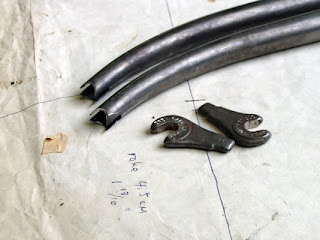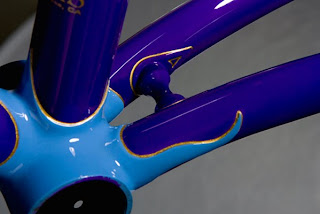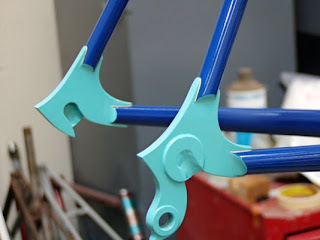There are numerous aspects of framebuilding, related to making
hand built bicycles in small numbers. Most importantly, there are
the considerations and concepts of designing the frame. This will
include "fitting" the frame, which includes looking at the client's
body dimensions, riding style, intended use, and rider's age. The
other part involves selecting the materials, actual construction,
and finish.
There are countless theories and formulas, and even computer
generated models, which are supposed to help us determine a
particular frame for a given rider. There are many factors that
must be taken into consideration. Many builders will simply
copy designs that have worked in the past. My method is to
study the machine (s) the rider has had experience with, up to
the point of ordering a new custom bicycle. I then ask a whole
lot of questions about their experiences with their bicycles.
Some of the questions are asked of every client, while some
questions will be specifically related to that individual. I probe
for the key bits of information, about how to best suit the rider.
I consider how to improve what may be lacking in their
previous bikes. Sometimes the client is just seeking a
frame with distinction and flair, beyond the readily available,
that performs as well as what they have. Note that great riding
bicycles can come from anywhere, including high production
companies. Each framebuilder has a personality and style
of their own, which is reflected in the frame. High volume
companies cannot do this. I believe my method is one of
the most sound, owing to my many years of riding, racing,
building for myself, and building for others......... this is one
of the reasons why people seek me out.
Once I know the needs of the user, it becomes a matter of
how much time and effort one is willing to put into making
the frame special and distinctive. Most people call this
"craftsmanship". This is where debate sometimes begin......
which frame is better? It really is a matter of personal taste.
Certainly, there are some methods of making a distinctive
machine that requires great skill and a good eye for aesthetics.
To a client that cannot detect these subtle differences, this may
mean nothing. The same goes for designs that are more than
what the client expects or likes.
I feel that my work falls in the middle of these extremes,
in that most can appreciate my style, even if they don't
really understand how much effort it takes. That being
said, I generally don't go to the extreme, trying to make
my lugs look like jewelry. I make a bike that pleases my
eye and satisfies my soul. Even though my extra effort is
not always rewarded monetarily, my "payment" for this
is self-satisfaction.
When the finished product makes the client happy,
and if some appreciate my skill and effort, then I feel
complete. Builders who refuse to put in the effort, much
of which involves lots of time, without financial considerations,
are simply not driven as craftsmen, in the purest sense.
These people are in the "business" of framebuilding.
Framebuilding was apparently my destiny and purpose
in life. Therefore, money only, is not a consideration in
my work, as compared to my need to fulfill that destiny.
I am satisfied that some consider me to be one of the best
framebuilders of all time; and that is what motivates me.
That may sound "corny" to some; but the truly sensitive
observers see that in my work.
Talk is cheap. The work must speak for itself. Simple as that.
Baylis Handmade Cycles.




































